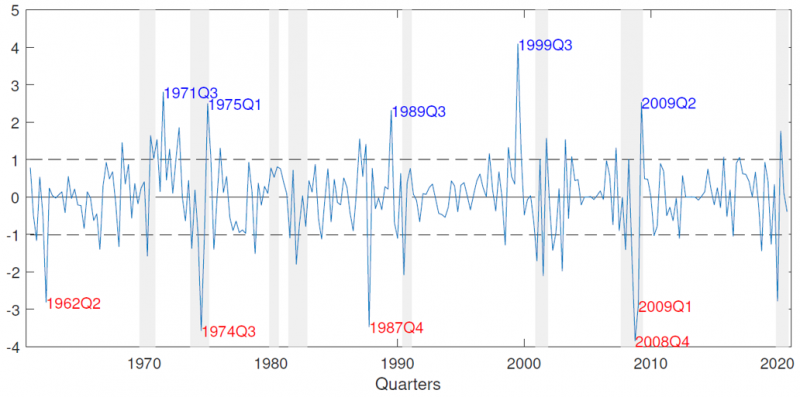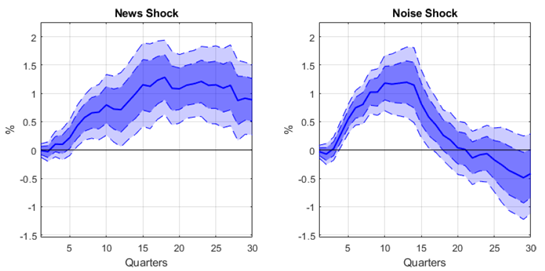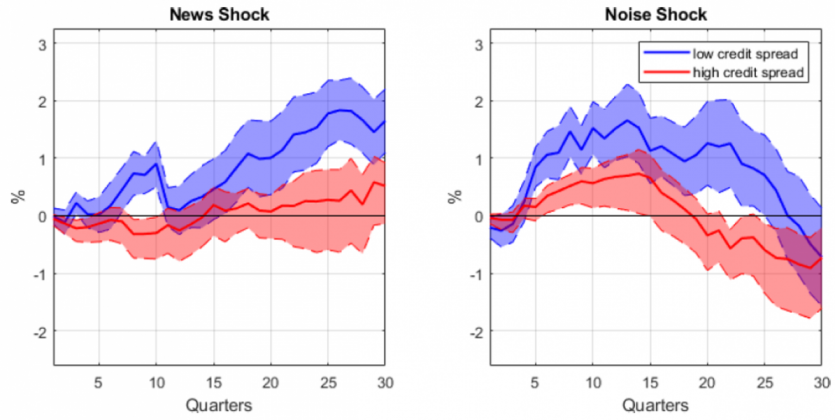

Identifying the drivers of credit cycles is crucial for prudential regulation. We decompose historical fluctuations in asset prices into fundamental (or news) and noise shocks and show that noise shocks can lead to unsustainable credit booms, especially when risk premiums are low. Instead, news shocks lead to credit expansions that do not entail substantial build-up of systemic risks. We shed light on a new debt overhang channel in the transmission mechanism of noise shocks. These insights are supported by both theoretical and empirical perspectives.
Credit growth is a widespread but imperfect indicator of the actual risks in the financial system. A popular narrative is that credit is susceptible to non-fundamental increases in asset prices, allowing credit to grow beyond its long-term average. Classic examples are the credit boom and bust in Japan during the 1980s, the telecommunications sector swing in the US in the late 1990s or the mortgage credit booms in the pre-2008 period in countries such as the US, Ireland, Spain, and Denmark. However, several historical episodes deviate from this narrative. One can have a notable increase in corporate credit but without a substantial build-up of systemic risks, like in the case of the US during the 1980s or China during the 2010s.
In our recent work (Gerba et al., 2023), we propose a macroeconomic model of credit demand-driven boom-bust cycles, where agents receive noisy signals about future productivity. A signal that turns out to be correct is referred to as a news shock, and a signal that turns out to be incorrect as a noise shock. We derive two main predictions that work through a novel debt overhang channel.
First, news and noise shocks lead to a boom in credit and the real economy. Credit demand drives this credit boom. In response to higher expected future productivity, firms invest more. Also, future default risk falls, which reduces credit spreads. Consequently, firms issue more debt. Endogenous credit supply amplifies the credit boom because the fall in credit spreads increases the net worth of financial intermediaries, which relaxes their financial constraints. Whether news or noise shocks drive a credit boom is not distinguishable with contemporaneous information available.
Second, noise shocks lead to a bust in credit and the real economy, while news shocks do not. Boom-bust cycles are the result of a debt overhang effect (Myers, 1977) and a leverage ratchet effect (Admati et al., 2018). These effects arise endogenously because of defaultable long-term debt. A news shock to productivity leads firms and intermediaries to increase their debt. If the news shock fails to realise, firms maintain a high leverage because of the leverage ratchet effect. The high leverage drags investment down because of the debt overhang effect. Future default risk rises, and credit spreads rise. Endogenous credit supply amplifies the bust, as higher credit spreads reduce the net worth of financial intermediaries.
In sum, the theoretical model delivers three testable predictions for the empirical investigation. First, news and noise shocks lead to a boom that results in an expansion of the real economy and a rise in credit. Second, unlike news shocks, noise shocks lead to an economic bust. Third, lenient credit supply conditions amplify these boom-bust cycles.
We extract a news and a noise shock from historical US stock price and dividend data, following the approach of Forni et al. (2017). Intuitively, noise shocks are identified as shocks to asset prices unrelated to past, current, and future potential output.1 Figure 1 displays the resulting noise shock series. It is standardised to zero mean and unit variance. NBER recessions are marked in grey. We highlight the five largest positive and negative noise shocks. For example, the 1974Q3 noise shock is contemporaneous to the Nixon resignation, the 1987Q4 shock coincides with the boom and bust around the 1987 stock market crash. The positive 1999Q3 noise shock marks the peak of the dotcom bubble. The 2008Q4 shock occurs contemporaneously to the peak of the Great Financial Crisis, while the 2009Q2 shock marks its end in the US.2
Based on local projection regressions (Jordà, 2005), we estimate the impact of noise shocks on US credit to non-financial firms. Figure 2 displays the results. A one standard deviation news shock leads to a permanent long-run increase in credit of around 1 per cent. The impact effect of the shock on the level of firm credit is 0. It increases over time and peaks after 10 quarters. This implies that the shock leads to increased credit growth for around 10 quarters. A one standard deviation noise shock, on the other hand, leads to a transitory increase in the level of credit. Again, it peaks after around 10 quarters, but reverts thereafter. This implies that a noise shock leads to around 10 quarters of credit growth, followed by around 10 quarters of negative credit growth. The result is moreover robust to various alterations in model specification.
Figure 1: Noise shocks

Source: Author’s calculations. The chart plots the noise shocks recovered using the estimation procedure of Forni et al. (2017). The shaded grey areas mark NBER recession dates. The five largest positive (negative) shocks are marked in blue (red). The dashed, horizontal lines are +/- one standard deviation.
The intuition behind these results lies in the speed of information revelation contained in the shocks. Economic agents expect news shocks to contain valuable information about future business capacity of firms. The level of credit is a slow-moving variable, so adjusting takes a while. Similarly, a noise shock leads to a credit boom. Yet, as investors become increasingly certain that a noise shock is at the core, credit growth regresses for a similar length of time.
When investigating the effects on US real activity, we find that both news and noise shocks lead to economic expansions, albeit with a different persistence. In the case of news shocks, the expansion leads to a permanent increase in the level of GDP. Contrarily, following noise shocks, the expansion is very temporary, lasting barely a year. It is followed by a protracted decline in GDP growth, as the economy corrects for the unrealized capacity stretch. This pattern remains for all other macroeconomic aggregates. Apparently, both news and noise shocks lead to co-movement of output, consumption, investment, hours, interest rates, and credit. The challenge lies in identifying the source of these cycle. For more details see Gerba et al. (2023).
These results provide evidence in favor of the first and second hypothesis derived from the theoretical model.
Figure 2: The effect of news and noise shocks on credit to the non-financial sector

Source: Author’s calculations. The confidence levels depicted are 68 per cent (dark shaded area) and 90 per cent (light shaded area). Standard errors correct for autocorrelation of the residuals using a Newey-West estimator. Estimation sample: 1961Q1-2020Q4.
Finally, we study the state dependent response of leverage to either shock, and plot the results in Figure 3. The red impulse response is that in periods of high-risk premiums, while the blue represents the response during periods of low-risk premiums. The figure plots impulse responses of US total credit to the non-financial sector.
The main result is that state contingency matters. Meanwhile for the noise shock, total credit rises in both states (albeit by relatively more in a low-risk premium state), for a news shock, the increase is statistically significant only in a low-risk premium state. On the opposite end, total credit growth reverts and falls below trend in both states following a noise shock, although almost 10 quarters sooner in a high-risk premium state. Overall credit conditions matter, and the boom-bust cycle generated by a noise shock is more pronounced in a high-risk premium state.
Figure 3: Effect of news and noise shocks on total US credit during loose (blue) and tight (red) credit conditions
Noise shocks are identified as shocks to asset prices unrelated to past, current, and future potential output. News shocks are linked to fundamental increases in productivity.

Source: Author’s calculations. The confidence levels depicted are 68 per cent (dark shaded area) and 90 per cent (light shaded area). Standard errors correct for autocorrelation of the residuals using a Newey-West estimator. Estimation sample: 1961Q1-2020Q4.
A possible explanation is that investors can leverage up in response to both news and noise shocks if credit conditions are lenient, but not if credit conditions are tight. This is in line with our theoretical model. There, news and noise shocks only lead to a decline in liquidity premiums if the leverage capacity of financial intermediaries is high. The decline in the liquidity premium in turn amplifies the credit boom and, in the case of a noise shock, leads the subsequent bust.
Our findings have implications for the potential conduct of macroprudential policy, since only some credit booms require regulatory tightening. Even when asset prices are high relative to fundamentals, credit growth does not automatically warrant a regulatory response, as high asset prices and credit growth might be driven by news about the future.
Admati, A., Demarzo, P., Hellwig, M., and Pfleiderer, P. (2018). “The Leverage Ratchet Effect.” Journal of Finance, 73 (1), 145-198.
Forni, M., Gambetti, L., Lippi, M., and Sala, L. (2017). “Noisy news in business cycles.” American Economic Journal: Macroeconomics, 9(4), 122-152.
Gerba, E., Leiva-León, D. and Poeschl, J. (2023) “When credit expansions become troublesome: The story of investor sentiments.” Danmarks Nationalbank Working Paper Nº 194.
Jordà, O. 2005. “Estimation and Inference of Impulse Responses by Local Projections.” American Economic Review, 95 (1), 161–182.
Myers, S. (1977). “Determinants of corporate borrowing.” Journal of Financial Economics 5 (2): 147-175.
News and noise shocks are retrieved from a vector autoregression model with the following variables: potential real GDP from the CBO, the 3-month treasury bill yield, Moody’s AAA corporate bond yield, the S&P500, and real GDP.
We have estimated the noise shocks by employing different sample sizes, providing virtually no historical revisions on the estimates. This feature favours the use of our framework in real time.